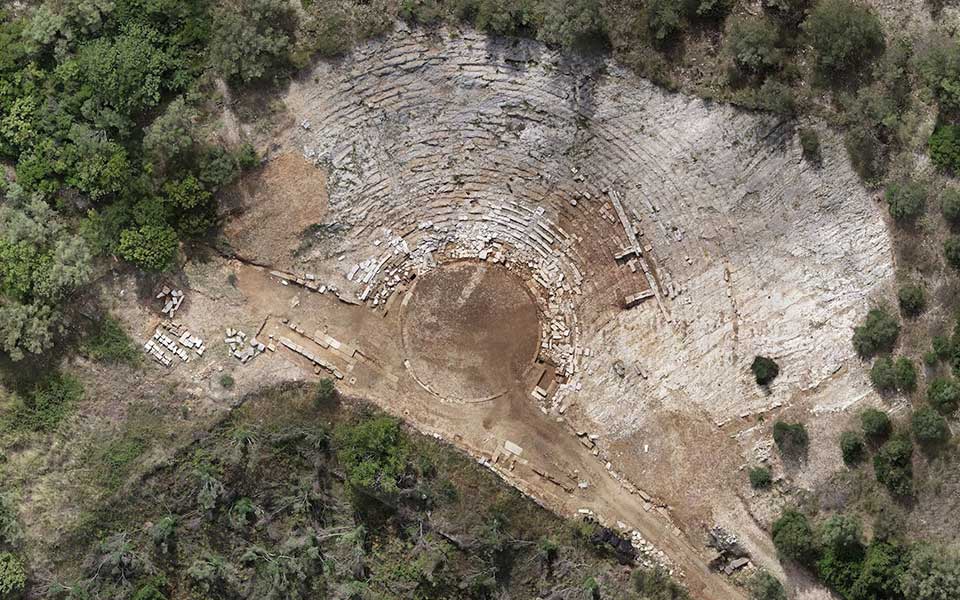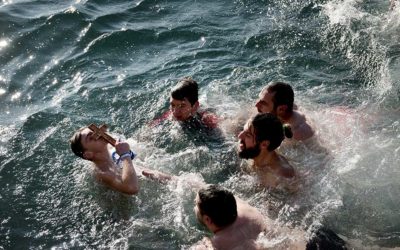The first ancient theater ever discovered in the Ionian Islands is located in the heart of the ancient city of Lefkada, established before the end of the 7th century BC.
The Ministry of Culture describes the find as the most important and imposing monument in the region, providing details about the archaeological excavations and research that uncovered the ancient theater of Lefkada.
This unique discovery, the first of its kind in the Ionian Islands, is located in the heart of the ancient city of Lefkada, which was established by Corinthians at the northeastern tip of the island before the end of the 7th century BC.
Lefkada was a powerful city-state that, thanks to its strategic position along maritime routes, enjoyed significant economic and cultural prosperity. Salvage excavations by the Ephorate of Antiquities of Aetolia-Acarnania and Lefkada have revealed extensive archaeological remains, including parts of the city walls, residential structures, cemeteries, and the harbor.

The theater and the view toward the channel, the Acarnanian coast, and Preveza.
© Ministry of Culture
According to the Ministry of Culture, the only systematic excavation on the island – since the major digs undertaken by W. Dörpfeld – took place in recent years, with the express purpose of uncovering the theater. The site lies about 3 km south of the modern city of Lefkada, on the northeastern slope of Koulmos hill. The hillside, covered in olive trees, offers a panoramic view of the channel and the coastal plain where the ancient city once extended.
Until 2015, very little was known about the theater, based only on test trenches from 1901 by E. Kruger, a collaborator of W. Dörpfeld, as documented in the book Alt Ithaka. After the trenches were filled in, the theater’s location was eventually forgotten, becoming overgrown with olive groves and makeshift storage buildings.
The distinct geomorphology of the area and visible ancient remains on the surface led to the rediscovery of the theater’s location in 1997 by the 16th Ephorate of Prehistoric and Classical Antiquities. In 2015, initial efforts for its excavation, under the supervision of Dr. Olympia Vikatos, were made possible through collaboration with then-mayor of Lefkada K. Drakontaeidis and support from the cultural association “DIAZOMA.” Initial test trenches, funded by the municipality, revealed seats, the orchestra, and the retaining wall of the stage.

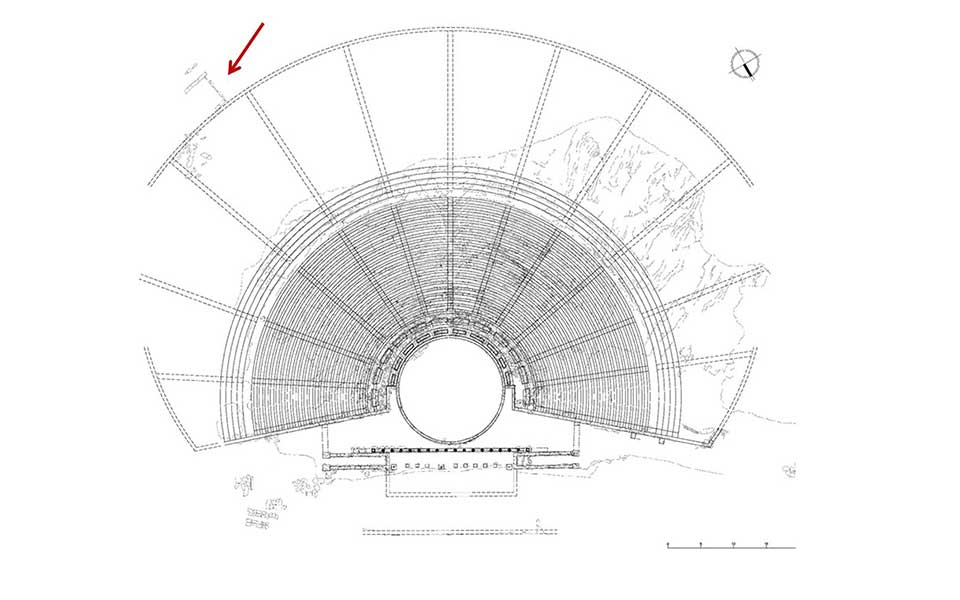
Design rendering of the theater.
© Ministry of Culture
Full excavations began in 2017, led by the Ephorate of Antiquities of Aetolia-Acarnania and Lefkada, with €200,000 in funding from the Ionian Islands Region and the Municipality of Lefkada, as part of an agreement with the Ministry of Culture. It took five phases for the team to finally uncover the large, impressive theater in 2023.
The excavation is directed by Dr. Olympia Vikatos, Director General of Antiquities and Cultural Heritage and former head of the Ephorate. The team includes archaeologists Vivian Staikou and Barbara Gkiza, surveyor George Lolos, architect Nikos Chatzidakis, and art conservator Aphrodite Tiligada.
The excavation was particularly challenging, requiring the removal of numerous olive trees, extensive earthmoving, the demolition of later structures, and the relocation of numerous architectural elements. The excavation revealed most of the cavea (seating area), the orchestra, the drainage channel (euripos), the passageways (parodoi), retaining walls, and most of the stage building.
The state of the monument, especially the upper part of the cavea, is poor due to both ancient and modern human activity that included agricultural use of the land.
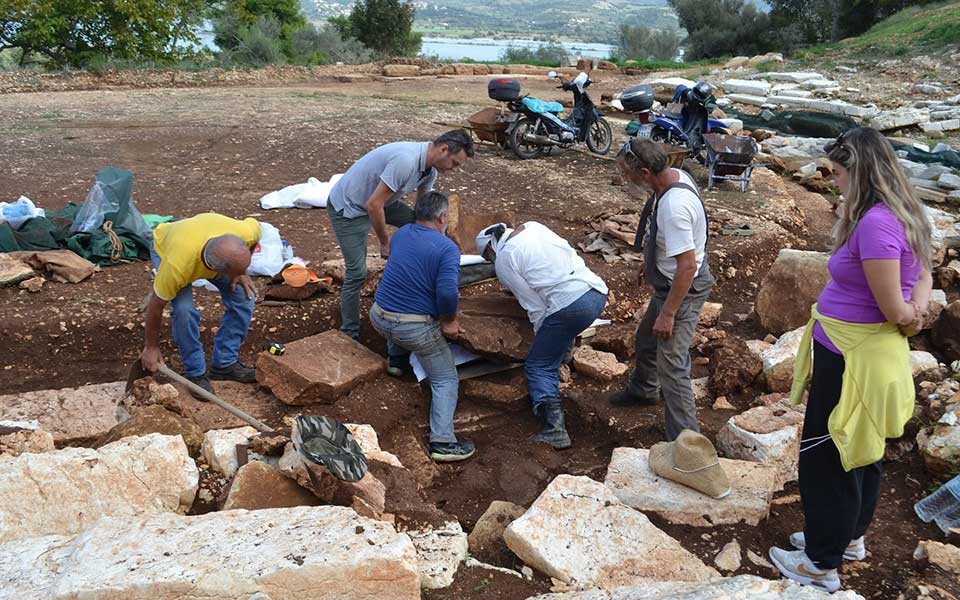
Throne transportation works in 2023.
© Ministry of Culture
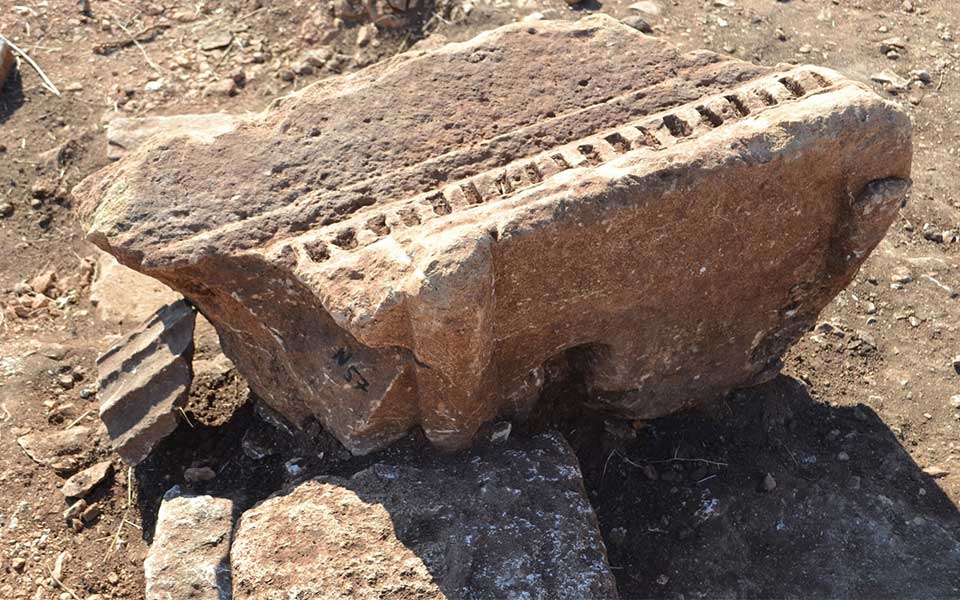
Epistyle in the southern passage of the theater.
© Ministry of Culture
The theater is oriented NE/SW and is divided into 12 seating sections by 13 staircases (0.72–0.78m wide). The lower part of the cavea is better preserved, especially the central area, where limestone coverings, stair risers, and aisle slabs remain intact.
The main theater has 21 rows of seats, and above the 21st row, a walkway (diazoma) likely existed. Above that, three rows were carved into the rock, while the upper theater (epitheatron) shows a uniformly sloped rock surface, suggesting it was never completed.
With 24 rows, the theater could accommodate about 3,500 spectators. With the upper theater fully developed, capacity could have reached 10,000 to 11,000 people.
Thrones for prominent figures were found, consisting of two seats joined together, with a total length of 2.6m. The orchestra, partly carved into the rock, forms a complete circle with an external diameter of 16.65m and is surrounded by a stone frame made up of three rows of stones, featuring molding at the base and a band in the upper part of their front.
The particularly elaborate drainage channel running around the perimeter of the orchestra was partially investigated.

Snapshot from the olive tree cutting works in 2017.
© Ministry of Culture
One of the most interesting discoveries is the remains of three stone thrones, elaborately decorated with lion legs, dolphins, birds, sirens, and more. These were likely intended for priests, city officials, or officials of the Acarnanian League.
The two retaining walls of the cavea are preserved at lengths of 28m and 20.4m (north and south, respectively). The stage building measures 20m long and 13m wide and is preserved at the level of the column base. Numerous column fragments made of sandstone and entablature pieces allow for a reconstruction of the Ionic stage front, which had 16 engaged half-columns.
On either side of the Ionic colonnade were 9m-long ramps leading to the logeion (the roof of the colonnade where actors performed). The entranceways (parodoi) were closed off with gates at the beginning of each ramp. A strong retaining wall, 13m behind the proscenium and at a much lower level, formed the eastern limit of the stage complex.

The city of ancient Lefkada with the location of the theater. In the background, the channel is visible.
© Ministry of Culture
Construction of the theater likely began in the 4th century BC, during a time of economic growth and prosperity for the city that saw many public buildings erected. However, structural details suggest later modifications. In Roman times, it shared the city’s fate – gradual decline. After the founding of Nicopolis by Octavian Augustus in 31 BC, many Lefkadians were forcibly relocated to the new city.
The theater was likely abandoned at the end of antiquity, with much of its material repurposed for newer buildings, some of which were built directly atop the seating area. Though scarred by time – and particularly by human intervention – the theater, harmoniously integrated into the hillside with a panoramic view of the wider area, is undoubtedly the most significant and imposing monument uncovered in ancient Lefkada.
This article was previously published in Greek at kathimerini.gr.

